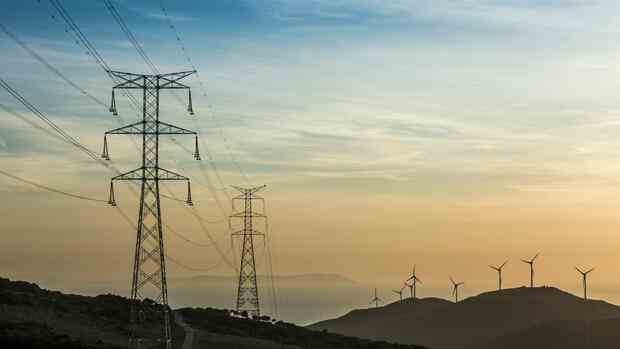Madrid Numerous EU heads of government have been envious of Spain and Portugal for months: since the middle of the year, electricity has been significantly cheaper there than in the rest of Europe. The reason for this is the Iberian gas price cap. This sets an upper limit for the gas used to produce electricity and thus works differently from the much-discussed price cap of the European Union (EU). Under special market conditions, this prohibits trading in gas above EUR 180 per megawatt hour.
In the EU negotiations, many countries had demanded that the Iberian model be applied across Europe. However, EU Commission officials warned against it and referred to Spain’s experience with it.
In fact, the record on the Iberian Peninsula is mixed. Supporters of the cap argue the price cap has meant inflation in Spain has fallen to 6.8 percent, the lowest in the EU in November. Critics, like EU officials, counter that the cap has increased exports to France and gas consumption. Both are right.
Since mid-June, Spain and Portugal have capped the price of gas for power generation to an average of 50 euros per megawatt hour – which is well below the market price. In order to compensate the gas-fired power plants for the resulting price gap, they are reimbursed the difference between the cap and the market price – from consumers who have a regulated electricity tariff.
Top jobs of the day
Find the best jobs now and
be notified by email.
In Spain, this is around 40 percent of households and 70 percent of companies. Your tariff is linked to the daily changing prices on the spot market. Its users therefore immediately feel price fluctuations on the market. When world market prices started to rise last year, consumers in Spain were the first to notice.
Gas price cap affects inflation
However, the system means that the users of the regulated tariff feel the effect of the price cap directly – even though they finance the subsidy for the gas-fired power plants. According to the Spanish government, the price cap means they pay an average of 17 percent less for their electricity than they would without it.
>> Read also: Why the Iberian gas price cap is not a model for everyone
The reason: gas makes up only 20 percent of the Spanish electricity mix – and only these 20 percent subsidize consumers. However, since gas determines the price of all energy sources, the cap also lowers the prices of the remaining 80 percent of energy. It comes primarily from renewable energies and to a lesser extent from nuclear power plants.
Since the exploding energy costs as a result of the Ukraine war are the main reason for the high inflation rates, the lower electricity price is helping to lower inflation. However, experts also blame a statistical effect for the good Spanish figures: The national statistics office INE uses only the regulated tariff to calculate the national electricity price. However, like in Germany, 60 percent of households have a tariff that is tied to a fixed electricity price for a year or longer.
“There’s a certain bias to it,” says energy expert Ramón Mateo, director at the consultancy BeBartlet. Nevertheless, the regulated tariff is so important “that one can assume that the price cap has significantly reduced energy costs and thus inflation.”
Not only the Spaniards and Portuguese benefit from the cap, but also the French, unintentionally. Instead of previously exporting electricity to Spain, France imported 5,300 gigawatt hours from the neighboring country from August to the end of November. Since there was no hydropower in Portugal due to the dry summer, Spanish electricity exports to Portugal have also skyrocketed. It has increased almost sevenfold to 3100 gigawatt hours.
Spain used gas-fired power plants more than usual
Rising exports have contributed to Spain using its gas-fired power plants more than usual: gas and coal are only used when the cheapest energy sources – i.e. renewables and nuclear energy – have been exhausted. This is quickly the case with a sharp increase in demand. According to data from the gas network operator Enagas, Spanish gas consumption for electricity generation rose by 61 percent from January to the end of November compared to the previous year. In July, the plus was even 125 percent.
But this is not solely due to exports. “The gas price cap also provides an incentive to use more gas for electricity production,” says expert Mateo. The subsidy gives the combined cycle power plants a guarantee that their costs will be covered.
>>Read here: Spain’s Energy Minister – “This crisis threatens the continued existence of the EU”
However, the introduction of the price cap in mid-June also coincided with a particularly dry summer and correspondingly little hydropower could be used to generate electricity. In addition, several French nuclear power plants were shut down. “This suggests that gas consumption in Spain would have increased even without a price cap,” says Mateo. “It is difficult to assess to what extent the higher gas consumption is due to the price cap or other factors.”
On the other hand, it is undisputed that the cap reduces the profits of all suppliers, since the price of gas determines the price of all other forms of energy. If it is capped, nuclear power and energy from renewable sources will also become cheaper.
“The cap cost producers of nuclear power and renewable energies around five billion euros in revenue this year,” calculates José Luis Sancha, an energy expert at the Universidad Pontifica Comillas in Madrid.
Some consider this to be problematic. They argue that companies should have a strong incentive to invest heavily in additional renewable energy capacity to fight climate change. “The cap could slow down such investments,” warns Ana Maria Jaller-Makarewicz, an energy analyst at analysis firm IEEFA.
More: Price brake for food – This is how southern European countries want to stop inflation
